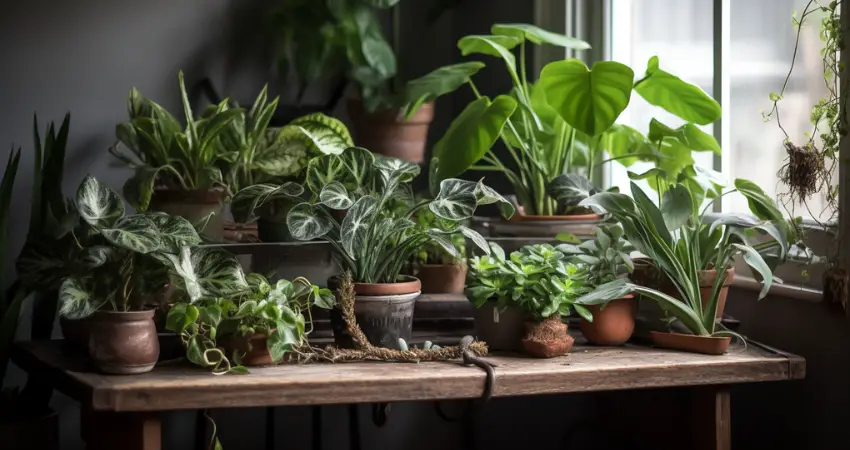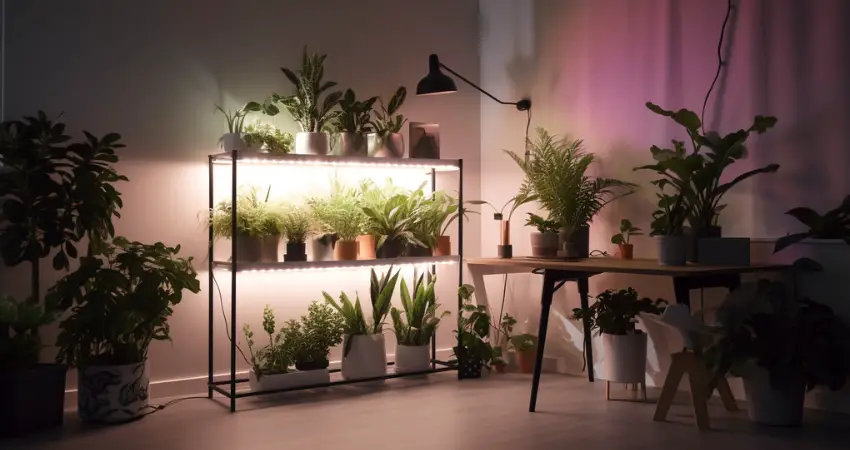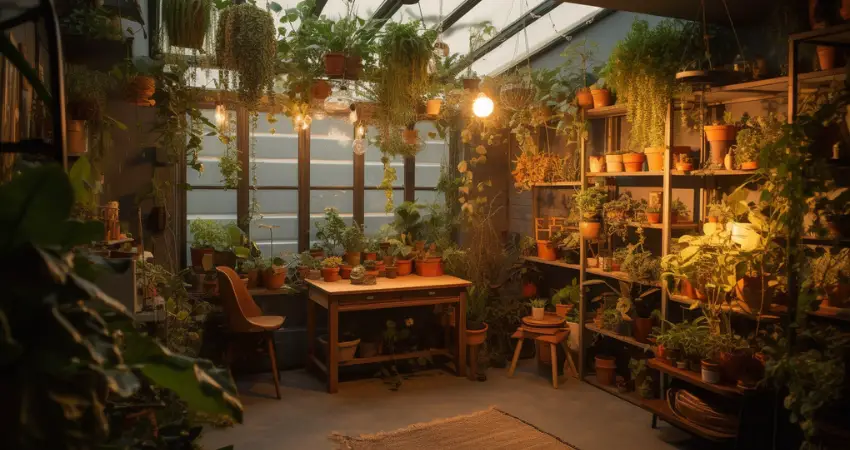The world of indoor gardening presents a unique challenge: providing adequate light for plants to thrive and flourish. Whether you’re a seasoned horticulturist or a budding plant enthusiast, understanding the differences between natural and artificial light is crucial for the success of your indoor plants.
This comprehensive guide will explore the intricacies of natural light and artificial light, examining their pros and cons to help you make informed decisions about the best lighting conditions for your indoor plants.
From the sun’s full spectrum to the customizable wavelengths of artificial light, we’ll delve into the science behind plant growth, energy efficiency, and environmental impact. Join us as we illuminate the path towards healthier, happier indoor plants with this detailed comparison of natural and artificial light sources.
Natural Light

Definition and characteristics
Natural light, also known as sunlight, is the primary source of light for plants on Earth. It encompasses a full spectrum of wavelengths, providing the perfect blend of light for photosynthesis and other plant processes. The intensity, duration, and quality of sunlight can vary depending on location, season, and weather conditions.
Pros of natural light for indoor plants
- Free and abundant source: Sunlight is a natural, renewable resource that doesn’t cost a dime. This makes it an attractive option for growing plants indoors, as it helps minimize expenses while still providing plants with the energy they need to flourish.
- Full spectrum of wavelengths: Sunlight provides a wide range of light wavelengths that plants need to grow and thrive. This enables plants to optimize their energy absorption and overall health. The full spectrum of sunlight includes ultraviolet (UV), visible, and infrared (IR) light, each of which plays a crucial role in various plant processes.
- Promotes healthy growth and development: Natural light encourages well-rounded and robust growth in plants, as it contains the ideal balance of light wavelengths. The result is stronger plants with healthier foliage, more vibrant colors, and better resistance to pests and diseases.
- Encourages photosynthesis and phototropism: Sunlight is essential for photosynthesis, the process by which plants convert light energy into chemical energy to fuel their growth. Additionally, phototropism, the phenomenon where plants grow towards a light source, is induced by natural light, which helps them maximize light absorption.
- Environmental benefits: Utilizing natural light reduces the need for artificial light sources, which can consume energy and contribute to greenhouse gas emissions. This makes using sunlight an eco-friendly choice for growing indoor plants.
Cons of natural light for indoor plants
- Limited by location and season: The availability of sunlight depends on your geographic location and the time of year. During winter months, sunlight may be scarce, making it difficult to provide sufficient light for some plants. Additionally, living in an apartment or a house with limited window space can also restrict access to natural light.
- Inconsistent intensity and duration: Sunlight’s intensity and duration can vary significantly depending on factors such as cloud cover, time of day, and season. This inconsistency can make it challenging to provide a stable light environment for indoor plants, which may negatively affect their growth and development.
- Potential for overheating and sunburn: Excessive direct sunlight can cause indoor plants to overheat, leading to wilting, dehydration, or even sunburn. Some plants are more sensitive to strong sunlight than others and may require additional shade or filtered light to prevent damage.
- Difficulty in controlling light conditions: Unlike artificial light sources, natural light is difficult to control and adjust based on a plant’s specific needs. This may result in suboptimal growing conditions for some indoor plants.
Maximizing natural light for indoor plants
- Choosing the right location: Place your plants near windows or other sources of natural light to maximize their exposure. South-facing windows typically receive the most sunlight, followed by east and west-facing windows.
- Reflective surfaces and light shelves: Use mirrors or other reflective surfaces to help distribute sunlight more evenly throughout your indoor space. Light shelves, which are horizontal surfaces placed above windows, can also help direct sunlight deeper into a room, ensuring that more plants receive adequate light.
- Managing heat and humidity: Monitor and adjust the temperature and humidity in your indoor space to ensure optimal growing conditions for your plants. Use blinds or curtains to prevent overheating and provide shade during the hottest parts of the day. Additionally, consider using a humidifier or placing a tray of water near your plants to maintain proper humidity levels.
Best indoor plants for natural light conditions
- High-light plants: Some plants thrive in bright, direct sunlight. Examples include succulents like aloe vera, jade plant, and various cacti species, as well as flowering plants like geraniums and hibiscus.
- Medium-light plants: These plants can tolerate indirect or filtered sunlight and are well-suited for rooms with east or west-facing windows. Examples include spider plants, pothos, and snake plants.
- Low-light plants: Certain plants can survive in lower light conditions, making them ideal for spaces with limited natural light. Examples include ZZ plants, peace lilies, and ferns.
Artificial Light

Definition and types
Artificial light sources are man-made and designed to mimic the characteristics of sunlight. They can be tailored to provide specific wavelengths and intensities, making them a versatile option for indoor plant growth. Common types of artificial light sources for plants include:
- Fluorescent lights: These lights are energy-efficient and provide a broad spectrum of light, making them suitable for many types of plants. They are commonly used in the form of compact fluorescent lights (CFLs) or fluorescent tubes.
- High-intensity discharge (HID) lights: HID lights produce a more intense light than fluorescents and are often used for larger growing spaces or plants with higher light requirements. They include metal halide (MH) and high-pressure sodium (HPS) lamps.
- Light-emitting diodes (LEDs): LEDs are energy-efficient, long-lasting, and customizable, making them a popular choice for indoor plant growth. They can be adjusted to emit specific wavelengths, allowing growers to optimize light conditions for different plant species.
Pros of artificial light for indoor plants
- Controlled and consistent light conditions: Artificial light sources provide a stable and consistent light environment, allowing growers to tailor the light conditions to a plant’s specific needs. This results in more predictable and controlled plant growth.
- Customizable spectrum and intensity: Artificial lights can be adjusted to provide the optimal spectrum and intensity for different plant species, ensuring that each plant receives the appropriate amount of light for its growth stage and type.
- Extended growing seasons and photoperiods: Artificial light sources enable growers to extend the growing season and manipulate photoperiods, which can encourage flowering, fruiting, or vegetative growth, depending on the plant’s needs.
- Indoor vertical farming and urban agriculture: Artificial lights have paved the way for innovative growing methods like indoor vertical farming and urban agriculture, allowing for food production in areas with limited space or unsuitable outdoor conditions.
- Ability to grow plants in any location: Artificial light sources enable the cultivation of plants in spaces with limited or no access to natural light, such as basements, offices, or apartments with few windows.
Cons of artificial light for indoor plants
- Initial costs and energy consumption: Artificial light sources can be costly to set up and may consume a significant amount of energy, depending on the type and number of lights used. This can lead to higher utility bills and a larger environmental footprint.
- Potential for light pollution: Excessive artificial light can contribute to light pollution, which disrupts ecosystems and negatively impacts human health and wildlife. It is essential to use artificial lighting responsibly and minimize its impact on the environment.
- Environmental concerns (e-waste, carbon footprint): The production, use, and disposal of artificial lights can contribute to e-waste and increase a household’s carbon footprint. Choosing energy-efficient lighting options and properly recycling used bulbs can help mitigate these concerns.
- Potential health risks for humans (blue light, UV exposure): Some artificial light sources, such as LEDs, emit blue light that can interfere with human sleep patterns if used excessively at night. Additionally, certain types of artificial lights, like some HID lamps, may emit harmful UV radiation if not properly shielded. It is important to select appropriate lighting options and use them responsibly to minimize potential health risks.
Optimizing artificial light for indoor plants
- Choosing the right type and spectrum of light: Select the appropriate artificial light source based on your plant’s needs and your growing environment. Consider factors such as energy efficiency, lifespan, and the ability to customize the light spectrum.
- Determining proper distance and intensity: Position artificial lights at the appropriate distance from your plants to ensure optimal light intensity without causing overheating or light stress. The ideal distance will vary depending on the type of light and the plant species.
- Setting appropriate photoperiods: Adjust the duration of artificial light exposure to mimic natural light cycles or manipulate plant growth and development. Most plants require a period of darkness each day, so using timers can help automate the lighting schedule.
- Efficient energy usage and reducing environmental impact: Choose energy-efficient lighting options, such as LEDs or CFLs, to minimize energy consumption and environmental impact. Additionally, ensure proper disposal or recycling of used bulbs to reduce e-waste.
Best indoor plants for artificial light conditions
- High-light plants: Many high-light plants can thrive under artificial light sources with sufficient intensity, such as HID lights or high-output LEDs. Examples include tomatoes, peppers, and certain flowering plants like orchids.
- Medium-light plants: Most medium-light plants can grow well under fluorescent lights or standard-output LEDs. Examples include herbs like basil and mint, as well as foliage plants like pothos and philodendrons.
- Low-light plants: Low-light plants typically do well under most artificial light sources, as long as the intensity is not too high. Examples include snake plants, ZZ plants, and peace lilies.
Comparing Natural Light and Artificial Light

Differences in spectrum, intensity, and consistency
Natural light provides a full spectrum of wavelengths, while artificial lights can be customized to emit specific wavelengths. The intensity and consistency of natural light can vary greatly depending on factors such as location and season, whereas artificial lights offer more stable and controllable conditions.
Effects on plant growth, yield, and quality
Both natural and artificial light sources can support healthy plant growth, but their effects on yield and quality may vary depending on the specific plant species and growing conditions. Some plants may thrive better under natural light, while others may benefit from the customization and control offered by artificial lights.
Environmental and economic considerations
Natural light is a free and renewable resource, making it an eco-friendly and cost-effective option for growing indoor plants. Artificial lights, on the other hand, can consume energy and contribute to environmental concerns like e-waste and carbon emissions. However, they also enable innovative growing methods like indoor vertical farming and urban agriculture, which can contribute to local food production and sustainability.
Applicability in different contexts (home, office, commercial spaces)
Natural light is an ideal option for growing plants in homes or offices with ample access to sunlight. Artificial lights offer more versatility and can be used in various settings, including homes, offices, and commercial spaces with limited or no access to natural light. They are particularly useful for large-scale indoor farming operations, where precise control over light conditions is essential.
Conclusion
Both natural and artificial light sources have their own set of pros and cons when it comes to growing indoor plants. Natural light is a free, eco-friendly option that promotes healthy plant growth, but it can be limited by factors such as location, season, and indoor space. Artificial light provides greater control over light conditions, allowing for customized and stable growing environments, but it can also come with increased costs and environmental concerns.
Ultimately, the best choice for your indoor plants will depend on your specific needs, preferences, and growing conditions. By understanding the advantages and drawbacks of both natural and artificial light sources, you can make an informed decision that maximizes the health and success of your indoor plants.
